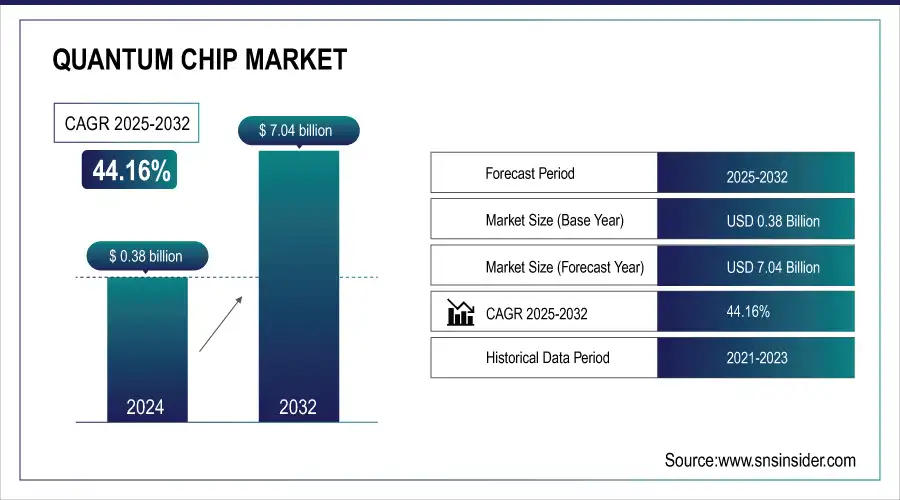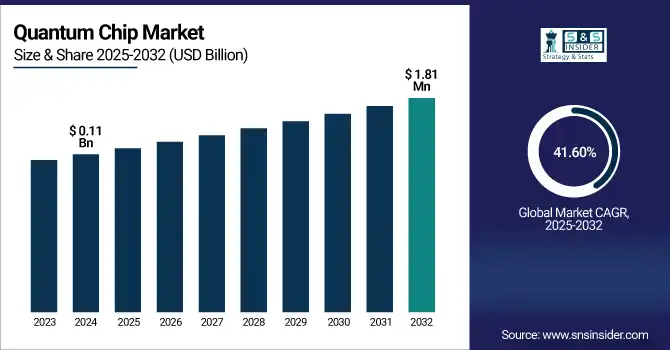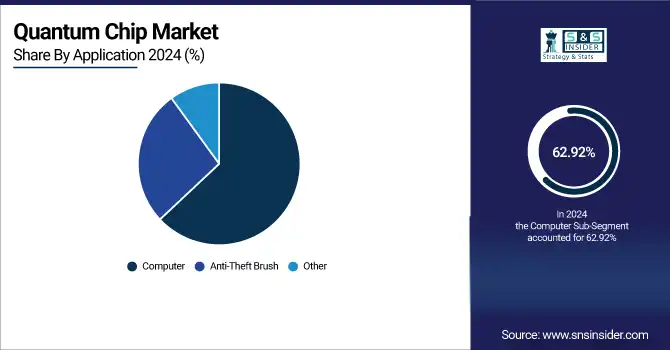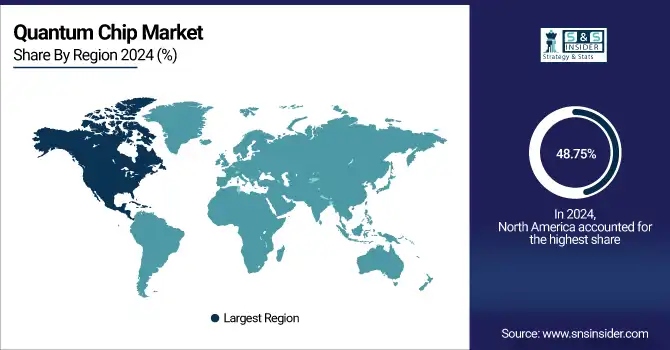Quantum Chip Market Size Analysis:
The Quantum Chip Market Size was valued at USD 0.38 billion in 2024 and is expected to reach USD 7.04 billion by 2032 and grow at a CAGR of 44.16% over the forecast period 2025-2032.

To Get more information On Quantum Chip Market - Request Free Sample Report
The worldwide Quantum Chip Market is witnessing accelerated technological innovation fueled by rising demand for quantum computing across industries such as defense, finance, and healthcare. Advances in superconducting and semiconductor quantum chips are fueling commercialization. The rise in investments, R&D efforts, and governmental support are conjoining a competitive market for epochal breakthroughs and mass industry adoption in the near term.
According to research, China has the highest share of patents filed in all types of quantum technologies, accounting for over half of the patents filed in every segment except quantum communications.
The U.S. Quantum Chip Market size was USD 0.11 billion in 2024 and is expected to reach USD 1.81 billion by 2032, growing at a CAGR of 41.60% over the forecast period of 2025–2032.
The U.S. Quantum Chip Market is picking up speed with robust federal backing, strategic investments, and vigorous involvement from technology giants and start-ups. Development of quantum computing infrastructure and growing emphasis on national security and high-end computing are fueling demand. The U.S. remains at the forefront of innovation, spearheading breakthroughs in scalable and reliable quantum chip technologies in major application sectors.
In September 2024, the U.S. Department of Energy announced $65 million in funding for 10 projects in Accelerated Research in Quantum Computing.
The U.S. Department of Defense's DARPA has expanded its Quantum Benchmarking Initiative, selecting 18 companies to test and advance various technologies for creating qubits, including superconducting qubits, trapped ion qubits, and other novel approaches.

Quantum Chip Market Dynamics
Key Drivers:
-
Growing Demand for High-Performance Computing Solutions in Strategic Sectors Boosts the Market Growth.
The demand for quantum chips is growing rapidly as quantum computing is more frequently used to solve major challenges in defense, finance, and drug discovery. These areas need quick processing, strong data security, and greater computing power, and that’s something quantum chips are designed to offer. This requirement is compounded with the widespread adoption of machine learning, big data analysis and algorithm based cryptography techniques. The demand for not only the next generation of quantum computing skills, but also a complementary infrastructure to support these gains, is reaching a fever pitch as industries place more focus on the disruptive computing ability of quantum chips.
PsiQuantum, a U.S.-based quantum computing company, secured $940 million from the Australian and Queensland governments to build the world's first utility-scale, fault-tolerant quantum computer in Brisbane by the end of 2027.
Restrain:
-
Lack of Standardized Quantum Hardware Protocols Across Platforms Restricts Compatibility and Slows Market Development.
Lack of standardized hardware interfaces, protocols, and design frameworks for different quantum computing platform is one of the significant restraints hampering the quantum chip market growth. This fragmentation leads to low inter-operation, which impairs the ability to connect quantum chips to broader compute environments or otherwise share among vendors. Developers or researchers are regularly suffering from inefficient migration cost due to transferring solutions from one platform to others with time lag and difficulty.
Opportunities:
-
Rising Public and Private Investments in Quantum Research and Startups Create New Growth Avenues for the Market.
Quantum computing development is pursued worldwide, and quantum government projects and super-large-scale integrated (SCL) enterprises are pouring a promising amount of funding into new quantum chip innovation. These investments are unlocking startup and academic innovation that is driving advances in chip design, materials science, and manufacturability. The rise of innovation hubs and consortia focused on quantum hardware is enabling new business models, incentivizing commercialization, and fostering technology industry diversification particularly in developing economies trying to leapfrog into advanced computing technologies.
IBM announced a USD 30 billion investment for research and development of quantum computing over the next five years, aiming to advance the field and maintain its leadership in the industry.
Challenges:
-
Ensuring Scalable Error Correction and Stable Qubit Coherence Poses a Major Engineering Challenge for Quantum Chip Developers.
Quantum chips are extremely sensitive to environmental noise, and keeping qubit stability or coherence continues to be a technical challenge. Any little fluctuation might result in errors and thus error correction protocols must be applied which are currently demanding in terms of computation. Materials, chip architecture, and cryogenics must evolve to allow for large-scale, fault-tolerant quantum systems. Without scalable reliability, efforts toward commercialization of a quantum computing platform may be confined merely to experimental or small-scale deployments, constraining the practical utilization of quantum computing platforms more generally.
Quantum Chip Market Segmentation Outlook:
By Type
The Superconducting Quantum Chip segment is dominated with 43.04% revenue share in 2024. Superconducting qubits are most commonly utilized because of their scalability to large quantum systems and stability. IBM and Google are among the leading product development companies in this area, with IBM's introduction of their Eagle chip and Google's Sycamore processor driving quantum computing technology. As the quantum chip industry expands, superconducting chips have a key function in making quantum systems practical for commercial and scientific use, catalyzing great advances in computational speed and accuracy.
The Ion Trap Quantum Chip market is also expected to fastest growth with a CAGR of 45.66% during the period from 2025 to 2032. Ion trap quantum computers utilize individual ions as qubits, which provide high accuracy and low error rates. Enterprises such as Honeywell and Microsoft have led the way with this technology, including Honeywell's recent release of their H1 quantum processor and Microsoft's ongoing innovation with their Azure Quantum platform. As the market for quantum chips grows, ion trap technologies are increasingly finding favor due to their strength and scalability, putting them in pole position to help shape the development of quantum computing.
By Application
The Computer segment is projected to dominated the quantum chip market share of 62.92% in 2024. Quantum chips have the potential to transform computing, allowing for faster and more effective solutions to difficult problems. Leaders such as IBM, Google, and Intel are in the forefront, with IBM unveiling its Eagle chip and Google developing its Sycamore processor. With increasing computing demands, quantum chips are increasingly needed to bring about breakthroughs in artificial intelligence, cryptography, and big data analytics, with considerable improvements over classical computing, thus fueling the future growth of the market.
The Anti-Theft Brush market is projected to fastest growth of 45.67% CAGR between 2025 and 2032. Such brushes are utilized to prevent theft by securing devices, commonly applied in sectors such as retail and transportation. Businesses such as 3M and Zebra Technologies have introduced innovative anti-theft products, embedding sophisticated quantum chips for improved security features. As the anti-theft market expands, the use of quantum chips in such devices is enhancing the effectiveness and safety of real-time monitoring and theft-preventing systems, thus enhancing the overall growth of the market in these sectors.

By End-User
The Computer segment is dominated the quantum chip market with a revenue share of 62.92% in 2024. Quantum chips have tremendous potential to revolutionize computing by cracking hard problems quickly and efficiently compared to conventional processors. Rigetti Computing and D-Wave Systems are at the forefront of this technology, with Rigetti's Aspen-9 chip and D-Wave's Advantage quantum processor opening up new avenues for quantum computing in artificial intelligence, optimization, and cryptography. As businesses demand more computing power, the advent of quantum chips will improve computing power, and growth in the quantum chip market, particularly for computing purposes, will increase at a faster rate.
The Anti-Theft Brush segment is expected to grow at the fastest CAGR of 45.67% during the period 2025-2032. They are used to protect products from theft and tampering, mainly in retail settings. Organizations such as Checkpoint Systems and Tyco Integrated Security are working on next-generation anti-theft solutions by implementing smart technology and quantum chips to enhance security. All these advances facilitate the production of more complex real-time monitoring systems, in which quantum chips enhance processing and accuracy of data. As the need for improved theft prevention rises, usage in the anti-theft brush market will contribute to the market's growth due to quantum chips.
Quantum Chip Market Regional Analysis:
The North America region is dominated the market, accounting for 48.75% of the revenue in 2024. The region is a hotbed of quantum chip innovation, with institutions such as the University of California and organizations such as Quantum Circuits, which specializes in creating superconducting quantum chips. Sustained partnerships and investments in quantum technologies in North America are propelling developments in quantum computing, solidifying the region as a quantum chips companies in the market.

Get Customized Report as per Your Business Requirement - Enquiry Now
-
The US is the largest market in North America and is the forefront of federal funding, research institutes and start-up ecosystem that contribute to the rapid innovation, commercialization and deployment of quantum technologies for defence, computing and industrial applications.
The Asia Pacific is expected to have the fastest growth rate, i.e., a CAGR of 45.98% between 2025 and 2032. South Korea and Australia are investing heavily in quantum research, with Q-CTRL and Silicon Quantum Computing at the forefront. Q-CTRL's quantum control innovations and Silicon Quantum's silicon-based quantum chip research are advancing quantum technology. This expansion is also driven by government support from the region and the growing interest in commercializing quantum computing among industries.
-
In the Asia Pacific region, China holds the largest market share for quantum chip because large government investment has led to coordinated national strategies in the region, that has led to significant advancements in quantum research, chip development, and applications for large scale network security, AI, and communications.
Europe Market is developing at the substantial pace owing to increasing government initiatives, advanced research organizations and growing private investments. Countries such as Germany, France and Finland are leading the pack with pioneering companies like IQM and Pasqal. Joint programmes between academia and industry are driving development, and so enabling Europe to play a leading role in the worldwide domain of quantum technology and chip innovation.
-
The European market is dominated by Germany with its concerted national strategy, developed industrial base and deep academic to tech company ties. State of the art research centers and active involvement in pan-European Quantum initiatives reinforces the country’s leadership.
The Middle East & Africa market is expanding owing to an increasing investment in technological emerging software companies in countries such as the UAE, Saudi Arabia, and South Africa. In Latin America, Brazil and Argentina are taking the lead and the growing interest in quantum research and development offers possibilities for innovation in the two countries.
Quantum Chip Companies are:
Major Key Players in Quantum Chip Market are Google, Amazon Web Services Inc., IBM, Microsoft, Silicon Quantum Computing, Ion Q, Honeywell, Fujitsu, Intel, Rigetti Computing and others.
Recent Development:
-
February 2025, Microsoft Announced, Majorana 1 is powered by a newly discovered state of matter created from topological conductors, potentially offering more stable qubits for quantum computing.
-
December 2024, Google Announced Willow achieved below-threshold quantum error correction and completed a Random Circuit Sampling task in 5 minutes, a benchmark that would take today's fastest supercomputers 10^25 years.
| Report Attributes | Details |
|---|---|
| Market Size in 2024 | USD 0.38 Billion |
| Market Size by 2032 | USD 7.04 Billion |
| CAGR | CAGR of 44.16% From 2025 to 2032 |
| Base Year | 2024 |
| Forecast Period | 2025-2032 |
| Historical Data | 2021-2023 |
| Report Scope & Coverage | Market Size, Segments Analysis, Competitive Landscape, Regional Analysis, DROC & SWOT Analysis, Forecast Outlook |
| Key Segments | •By Type (Superconducting Quantum Chip, Semiconductor Quantum Chip, Ion Trap Quantum Chip, Others) •By Application (Computer, Anti-Theft Brush, Other) •By End-User (Information Technology (IT) & Telecommunications, Banking, Financial Services and Insurance (BFSI), Aerospace & Defense, Research & Academia, Others) |
| Regional Analysis/Coverage | North America (US, Canada, Mexico), Europe (Germany, France, UK, Italy, Spain, Poland, Turkey, Rest of Europe), Asia Pacific (China, India, Japan, South Korea, Singapore, Australia, Rest of Asia Pacific), Middle East & Africa (UAE, Saudi Arabia, Qatar, South Africa, Rest of Middle East & Africa), Latin America (Brazil, Argentina, Rest of Latin America) |
| Company Profiles | Google, Amazon Web Services Inc., IBM, Microsoft, Silicon Quantum Computing, Ion Q, Honeywell, Fujitsu, Intel, Rigetti Computing. |

